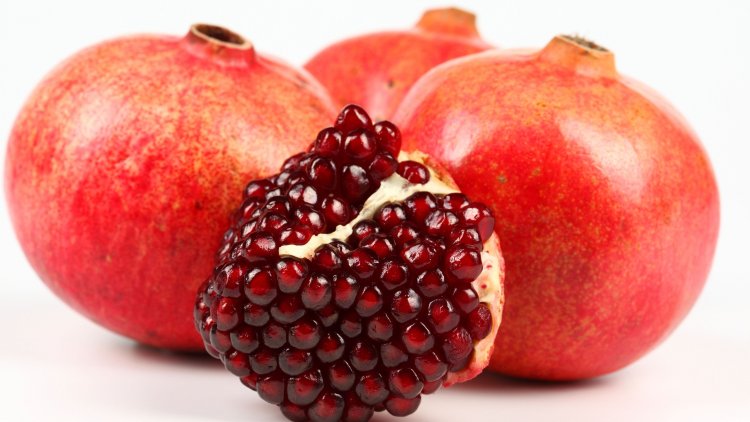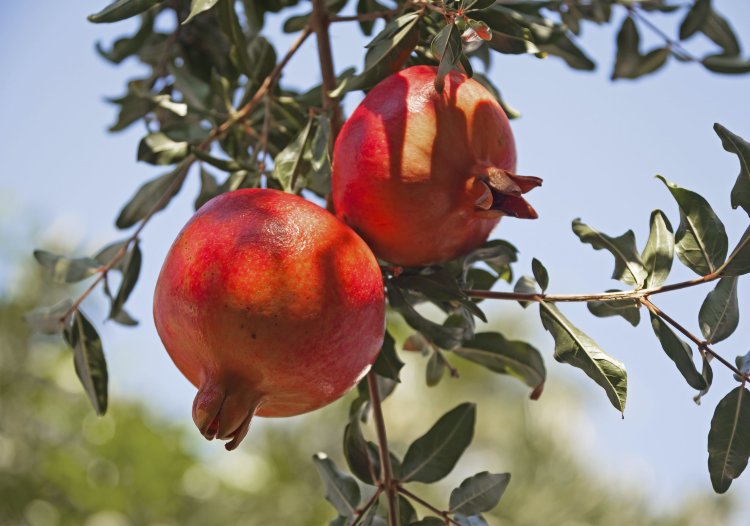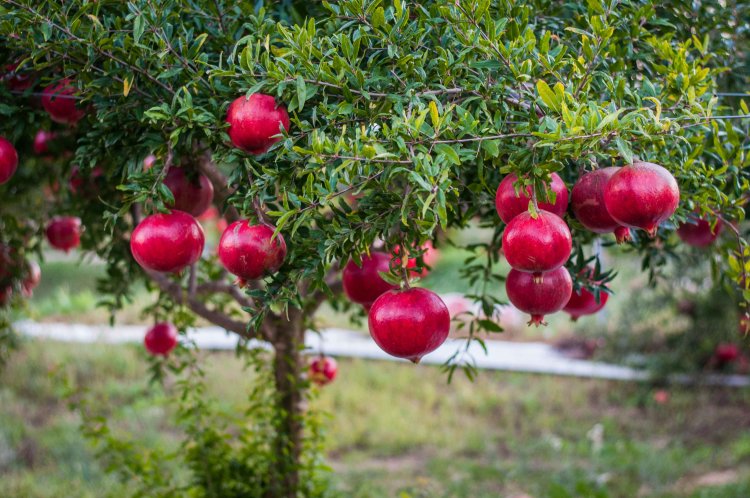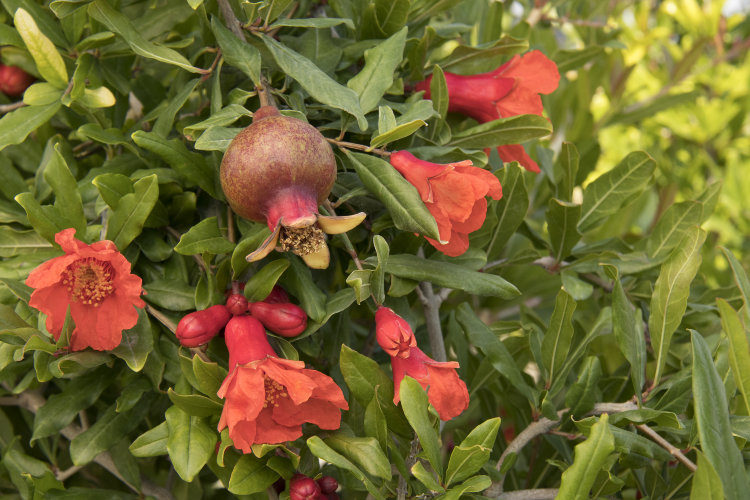- Overview
Common name: Pomegranate
Botanical name: Punica granatum Family: Punicacea Origin: South Asia Avg. Height X Width: 10' x 10' Varieties: Wonderful & Big Red Season: Year round Damage temp: 24 F
Pomegrante WonderFul Variety in a 3 Gallon Container. The pomegranate is known as “the hardest working fruit” in the world. The juice contains the highest concentration of naturally occurring antioxidants of any fruit. They are typically baseball to softball size, and are filled with transparent sacs that contain a seed and a flavorful pulp. They can be eaten out of hand or juiced for a drink. Great value since pomegrantes typically cost $3-$4 each and are one of the most medically beneficial fruit. They contain one of the highest concentrations of anti-oxidants to prevent aging related problems and keep you young. Wonderful is a popular large variety often found in grocery stores around Thanksgiving.
Description
Origin and Distribution
Cultivars
Pollination
Climate
Soil
Propagation
Culture
Harvesting and Yeild
Keeping Quality and Storage
Pests and Diseases
Food Uses
Food Values
Toxicity
Other Uses
Medicinal UsesSteeped in history and romance and almost in a class by itself, the pomegranate, Punica granatum L., belongs to the family Punicaceae which includes only one genus and two species, the other one, little-known, being P. protopunica Balf. peculiar to the island of Socotra. Despite its ancient background, the pomegranate has acquired only a relatively few commonly recognized vernacular names apart from its many regional epithets in India, most of which are variations on the Sanskrit dadima or dalim, and the Persian dulim or dulima. By the French it is called grenade; by the Spanish, granada (the fruit), granado (the plant); by the Dutch, granaatappel, and Germans, granatapfel; by the Italians, melogranato, melograno granato, pomo granato, or pomo punico. In Indonesia, it is gangsalan; in Thailand, tab tim; and in Malaya, delima. Brazilians know it as roma, romeira or romazeira. The Quecchi Indian name in Guatemala is granad. The Samoan name is limoni. The generic term, Punica, was the Roman name for Carthage from whence the best pomegranates came to Italy.
Description
An attractive shrub or small tree, to 20 or 30 ft (6 or 10 m) high, the pomegranate is much-branched, more or less spiny, and extremely long-lived, some specimens at Versailles known to have survived two centuries. It has a strong tendency to sucker from the base. The leaves are evergreen or deciduous, opposite or in whorls of 5 or 6, short-stemmed, oblong-lanceolate, 3/8 to 4 in (1-10 cm) long, leathery. Showy flowers are home on the branch tips singly or as many as 5 in a cluster. They are 1 1/4 in (3 cm) wide and characterized by the thick, tubular, red calyx having 5 to 8 fleshy, pointed sepals forming a vase from which emerge the 3 to 7 crinkled, red, white or variegated petals enclosing the numerous stamens. Nearly round, but crowned at the base by the prominent calyx, the fruit, 2 1/2 to 5 in (6.25-12.5 cm) wide, has a tough, leathery skin or rind, basically yellow more or less overlaid with light or deep pink or rich red. The interior is separated by membranous walls and white spongy tissue (rag) into compartments packed with transparent sacs filled with tart, flavorful, fleshy, juicy, red, pink or whitish pulp (technically the aril). In each sac, there is one white or red, angular, soft or hard seed. The seeds represent about 52% of the weight of the whole fruit.
Origin and Distribution
The pomegranate tree is native from Iran to the Himalayas in northern India and has been cultivated since ancient times throughout the Mediterranean region of Asia, Africa and Europe. The fruit was used in many ways as it is today and was featured in Egyptian mythology and art, praised in the Old Testament of the Bible and in the Babylonian Talmud, and it was carried by desert caravans for the sake of its thirst-quenching juice. It traveled to central and southern India from Iran about the first century A.D. and was reported growing in Indonesia in 1416. It has been widely cultivated throughout India and drier parts of southeast Asia, Malaya, the East Indies and tropical Africa. The most important growing regions are Egypt, China, Afghanistan, Pakistan, Bangladesh, Iran, Iraq, India, Burma and Saudi Arabia. There are some commercial orchards in Israel on the coastal plain and in the Jordan Valley. It is rather commonly planted and has become naturalized in Bermuda where it was first recorded in 1621, but only occasionally seen in the Bahamas, West Indies and warm areas of South and Central America. Many people grow it at cool altitudes in the interior of Honduras. In Mexico it is frequently planted, and it is sometimes found in gardens in Hawaii. The tree was introduced in California by Spanish settlers in 1769. It is grown for its fruit mostly in the dry zones of that state and Arizona. In California, commercial pomegranate cultivation is concentrated in Tulare, Fresno and Kern counties, with small plantings in Imperial and Riverside counties. There were 2,000 acres (810 ha) of hearing trees in these areas in the 1920's. Production declined from lack of demand in the 1930's but new plantings were made when demand increased in the 1960's.
Cultivars
There is little information available on the types grown in the Near East, except that the cultivars 'Ahmar', 'Aswad', 'Halwa' are important in Iraq, and 'Mangulati' in Saudi Arabia. 'Wonderful' and 'Red Loufani' are often grown in the Jewish sector of Israel, while the sweeter, less tangy 'Malissi' and 'Ras el Baghl', are favored in the Arab sector. In India there are several named cultivars. Preference is usually given those with fleshy, juicy pulp around the seeds. Types with relatively soft seeds are often classed as "seedless". Among the best are 'Bedana' and 'Kandhari'. 'Bedana' is medium to large, with brownish or whitish rind, pulp pinkish-white, sweet, seeds soft. 'Kandhari' is large, deep-red, with deep-pink or blood-red, subacid pulp and hard seeds. Others include: 'Alandi' ('Vadki')–medium-sized, with fleshy red or pink, subacid pulp, very hard seeds. 'Dholka'–large, yellow-red, with patches of dark-pink and purple at base, or all-over greenish-white; thick rind, fleshy, purplish-white or white, sweet, pulp; hard seeds. The plant is evergreen, non-suckering, desirable for commercial purposes in Delhi. 'Kabul'–large, with dark-red and pale-yellow rind; fleshy, dark-red, sweet, slightly bitter pulp. 'Muscat Red'–small to medium, with thin or fairly thick rind, fleshy, juicy, medium-sweet pulp, soft or medium-hard seeds. The plant is a moderately prolific bearer. 'Paper Shell'–round, medium to large, pale-yellow blushed with pink; with very thin rind, fleshy, reddish or pink, sweet, very juicy pulp and soft seeds. Bears heavily. 'Poona'–large, with dark-red, gray or grayish-green rind, sometimes spotted, and orange-red or pink-and-red pulp. 'Spanish Ruby'–round, small to medium or large; bright-red, with thin rind, fleshy, rose-colored, sweet, aromatic pulp, and small to medium, fairly soft seeds. Considered medium in quality. 'Vellodu'–medium to large, with medium-thick rind, fleshy, juicy pulp and medium-hard seeds. 'Muscat White'–large, creamy-white tinged with pink; thin rind; fleshy, cream-colored, sweet pulp; seeds medium-hard. Bears well. Desirable for commercial planting in Delhi. 'Wonderful'–originated as a cutting in Florida and propagated in California in 1896. The fruit is oblate, very large, dark purple-red, with medium-thick rind; deep-red, juicy, winey pulp; medium-hard seeds. Plant is vigorous and productive. In California, 'Spanish Ruby' and 'Sweet Fruited' were the leading cultivars in the past century, but were superseded by 'Wonderful'. In recent years 'Wonderful' is losing ground to the more colorful 'Grenada'. Mexicans take especial pride in the pomegranates of Tehuacan, Puebla. Many cultivars are grown, including 'Granada de China' and 'Granada Agria'. The Japanese dwarf pomegranate, P. granatum var. nana, is especially hardy and widely grown as an ornamental in pots. The flowers are scarlet, the fruit only 2 in (5 cm) wide but borne abundantly. Among other ornamental cultivars are 'Multiplex' with double, creamy white blooms; 'Chico', double, orange-red; 'Pleniflora', double, red; 'Rubra Plena', double, red; 'Mme. Legrelle' and 'Variegata', double, scarlet bordered and streaked with yellowish-white.
Pollination
The pomegranate is both self-pollinated and cross-pollinated by insects. There is very little wind dispersal of pollen. Self-pollination of bagged flowers has resulted in 45% fruit set. Cross-pollination has increased yield to 68%. In hermaphrodite flowers, 6 to 20% of the pollen may be infertile; in male, 14 to 28%. The size and fertility of the pollen vary with the cultivar and season.
Climate
The species is primarily mild-temperate to subtropical and naturally adapted to regions with cool winters and hot summers, but certain types are grown in home dooryards in tropical areas, such as various islands of the Bahamas and West Indies. In southern Florida, fruit development is enhanced after a cold winter. Elsewhere in the United States, the pomegranate can be grown outdoors as far north as Washington County, Utah, and Washington, D.C., though it doesn't fruit in the latter locations. It can be severely injured by temperatures below 12º F (-11.11º C). The plant favors a semi-arid climate and is extremely drought -tolerant.
Soil
The pomegranate thrives on calcareous, alkaline soil and on deep, acidic loam and a wide range of soils in between these extremes. In northern India, it is spontaneous on rockstrewn gravel.
Propagation
Pomegranate seeds germinate readily even when merely thrown onto the surface of loose soil and the seedlings spring up with vigor. However, to avoid seedling variation, selected cultivars are usually reproduced by means of hardwood cuttings 10 to 20 in (25-50 cm) long. Treatment with 50 ppm. indole-butyric acid and planting at a moisture level of 15.95% greatly enhances root development and survival. The cuttings are set in beds with 1 or 2 buds above the soil for 1 year, and then transplanted to the field. Grafting has never been successful but branches may be air-layered and suckers from a parent plant can be taken up and transplanted.
Culture
Rooted cuttings or seedlings are set out in pre-fertilized pits 2 ft (60 cm) deep and wide and are spaced 12 to 18 ft (3.5-5.5 m) apart, depending on the fertility of the soil. Initially, the plants are cut back to 24 to 30 in (60-75 cm) in height and after they branch out the lower branches are pruned to provide a clear main stem. Inasmuch as fruits are borne only at the tips of new growth, it is recommended that, for the first 3 years, the branches be judiciously shortened annually to encourage the maximum number of new shoots on all sides, prevent straggly development, and achieve a strong, well-framed plant. After the 3rd year, only suckers and dead branches are removed. For good fruit production, the plant must be irrigated. In Israel, brackish water is utilized with no adverse effect. In California, irrigation water is supplied by overhead sprinklers which also provide frost protection during cold spells. The pomegranate may begin to bear in 1 year after planting out, but 2 1/2 to 3 years is more common.
Harvesting And Yield
The fruits ripen 6 to 7 months after flowering. In Israel, cultivar 'Wonderful' is deemed ready for harvest when the soluble solids (SSC) reach 15%. In California, maturity has been equated with 1.8% titratable acidity (TA) and SSC of 17% or more. The fruit cannot be ripened off the tree even with ethylene treatment. Growers generally consider the fruit ready for harvest if it makes a metallic sound when tapped. The fruit must be picked before over maturity when it tends to crack open if rained upon or under certain conditions of atmospheric humidity, dehydration by winds, or insufficient irrigation. Of course, one might assume that ultimate splitting is the natural means of seed release and dispersal. The fruits should not be pulled off but clipped close to the base so as to leave no stem to cause damage in handling and shipping. Appearance is important, especially in the United States where pomegranates may be purchased primarily to enhance table arrangements and other fall (harvest-time) decorations. Too much sun exposure causes sunscald–brown, russeted blemishes and roughening of the rind. The fruit ships well, cushioned with paper or straw, in wooden crates or, for nearby markets, in baskets. Commercial California growers grade the fruits into 8 sizes, pack in layers, unwrapped but topped with shredded plastic, in covered wood boxes, precool rapidly, and ship in refrigerated trucks.
Keeping Quality and Storage
The pomegranate is equal to the apple in having a long storage life. It is best maintained at a temperature of 32º to 41º F (0º-5º C). The fruits improve in storage, become juicier and more flavorful; may be kept for a period of 7 months within this temperature range and at 80 to 85% relative humidity, without shrinking or spoiling. At 95% relative humidity, the fruit can be kept only 2 months at 41º F (5º C); for longer periods at 50º F (10º C). After prolonged storage, internal breakdown is evidenced by faded, streaky pulp of flat flavor. 'Wonderful' pomegranates, stored in Israel for Christmas shipment to Europe, are subject to superficial browning ("husk scald"). Control has been achieved by delaying harvest and storing in 2% O2 at 35.6º F (2º C). Subsequent transfer to 68º F (20º C) dispels off-flavor from ethanol accumulation.
Pests and Diseases
The pomegranate butterfly, Virachola isocrates, lays eggs on flower-buds and the calyx of developing fruits; in a few days the caterpillars enter the fruit by way of the calyx. These fruit borers may cause loss of an entire crop unless the flowers are sprayed 2 times 30 days apart. A stem borer sometimes makes holes right through the branches. Twig dieback may be caused by either Pleuroplaconema or Ceuthospora Phyllosticta. Discoloration of fruits and seeds results from infestation by Aspergillus castaneus. The fruits may be sometimes disfigured by Sphaceloma punicae. Dry rot from Phomopsis sp. or Zythia versoniana may destroy as much as 80% of the crop unless these organisms are controlled by appropriate spraying measures. Excessive rain during the ripening season may induce soft rot. A post-harvest rot caused by Alternaria solani was observed in India in 1974. It is particularly prevalent in cracked fruits. Minor problems are leaf and fruit spot caused by Cercospora, Gloeosporium and Pestalotia sp.; also foliar damage by whitefly, thrips, mealybugs and scale insects; and defoliation by Euproctis spp. and Archyophora dentula. Termites may infest the trunk. In India, paper or plastic bags or other covers may be put over the fruits to protect them from borers, birds, bats and squirrels.
Food Uses
For enjoying out-of-hand or at the table, the fruit is deeply scored several times vertically and then broken apart; then the clusters of juice sacs can be lifted out of the rind and eaten. Italians and other pomegranate fanciers consider this not a laborious handicap but a social, family or group activity, prolonging the pleasure of dining. In some countries, such as Iran, the juice is a very popular beverage. Most simply, the juice sacs are removed from the fruit and put through a basket press. Otherwise, the fruits are quartered and crushed, or the whole fruits may be pressed and the juice strained out. In Iran, the cut-open fruits may be stomped by a person wearing special shoes in a clay tub and the juice runs through outlets into clay troughs. Hydraulic extraction of juice should be at a pressure of less than 100 psi to avoid undue yield of tannin. The juice from crushed whole fruits contains excess tannin from the rind (as much as .175%) and this is precipitated out by a gelatin process. After filtering, the juice may be preserved by adding sodium benzoate or it may be pasteurized for 30 minutes, allowed to settle for 2 days, then strained and bottled. For beverage purposes, it is usually sweetened. Housewives in South Carolina make pomegranate jelly by adding 7 1/2 cups of sugar and 1 bottle of liquid pectin for every 4 cups of juice. In Saudi Arabia, the juice sacs may be frozen intact or the extracted juice may be concentrated and frozen, for future use. Pomegranate juice is widely made into grenadine for use in mixed drinks. In the Asiatic countries it may be made into a thick sirup for use as a sauce. It is also often converted into wine. In the home kitchen, the juice can be easily extracted by reaming the halved fruits on an ordinary orange-juice squeezer. In northern India, a major use of the wild fruits is for the preparation of "anardana"–the juice sacs being dried in the sun for 10 to 15 days and then sold as a spice.
Food Value Per 100 g of Edible Portion*
Calories 63-78
Moisture 72.6-86.4 g
Protein 0.05-1.6 g
Fat Trace only to 0.9 g
Carbohydrates 15.4-19.6 g
Fiber 3.4-5.0 g
Ash 0.36-0.73 g
Calcium 3-12 mg
Phosphorus 8-37 mg
Iron 0.3-1.2 mg
Sodium 3 mg
Potassium 259 mg
Carotene None to Trace
Thiamine 0.003 mg
Riboflavin 0.012-0.03 mg
Niacin 0.180-0.3 mg
Ascorbic Acid 4-4.2 mg
Citric Acid 0.46-3.6 mg
Boric Acid 0.005 mg
*Analyses of fresh juice sacs made by various investigators.
Toxicity
A tannin content of no more than 0.25% in the edible portion is the desideratum. Many studies have shown that tannin is carcinogenic and excessive ingestion of tannin from one or more sources, over a prolonged period, is detrimental to health. (See also "Medicinal Uses" regarding overdoses of bark.)
Other Uses
All parts of the tree have been utilized as sources of tannin for curing leather. The trunk bark contains 10 to 25% tannin and was formerly important in the production of Morocco leather. The root bark has a 28% tannin content, the leaves, 11%, and the fruit rind as much as 26%. The latter is a by-product of the "anardana" industry. Both the rind and the flowers yield dyes for textiles. Ink can be made by steeping the leaves in vinegar. In Japan, an insecticide is derived from the bark. The pale-yellow wood is very hard and, while available only in small dimensions, is used for walking-sticks and in woodcrafts.
Medicinal Uses
The juice of wild pomegranates yields citric acid and sodium citrate for pharmaceutical purposes. Pomegranate juice enters into preparations for treating dyspepsia and is considered beneficial in leprosy. The bark of the stem and root contains several alkaloids including isopelletierine which is active against tapeworms. Either a decoction of the bark, which is very bitter, or the safer, insoluble Pelletierine Tannate may be employed. Overdoses are emetic and purgative, produce dilation of pupila, dimness of sight, muscular weakness and paralysis. Because of their tannin content, extracts of the bark, leaves, immature fruit and fruit rind have been given as astringents to halt diarrhea, dysentery and hemorrhages. Dried, pulverized flower buds are employed as a remedy for bronchitis. In Mexico, a decoction of the flowers is gargled to relieve oral and throat inflammation. Leaves, seeds, roots and bark have displayed hypotensive, antispasmodic and anthelmintic activity in bioassay. - Features
weight: 9.99 lbs : - Reviews1










I wonder how is it that I'm finding out about Plantogram and their beautiful trees just now! When I opened that box and saw my trees(I had ordered 2 different trees),I was speechless! This pomegranate tree was tall,full,with new growth all over it! I've had a few good experiences buying trees online and a Lot of bad ones! I could have saved myself the headaches, buying here in the first place. Very satisfied customer!